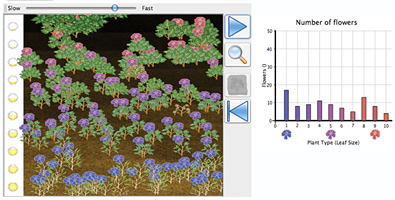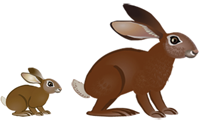Beginning with Big Ideas: Are Students Ready for Evolution?
Although we originally proposed the term “Evolution Readiness” to the National Science Foundation in 2008, it still took a team of scientists, curriculum developers, measurement experts, and software developers from the Concord Consortium and Boston College several months to define readiness when we began the project. Three years later, we now have a better idea of what fourth graders are ready to learn—and what’s hard for them.

For ten-year-olds the time to their next birthday can seem like forever. With this in mind, we decided not to try to convey to them the immense stretches of time required to produce major changes in species. We also realized that our young students were unlikely to embrace microscopic explanations for macroscopic phenomena — for example, that variations between organisms are caused by invisible things called genes. In the end, we settled on a collection of 11 BIG IDEAS that cover the “kid-size” aspects of evolutionary theory, leaving out the very slow and the very small.
We were aware from the start that some of our big ideas would be much harder to teach than others. Which concepts would students be able to learn? Would we find it virtually impossible to teach the more advanced concepts? In order to find out, we developed a test that included a few questions that we weren’t sure any students would answer correctly.
The learning goals of the Evolution Readiness project fall into 11 BIG IDEAS (ideas so big they’re capitalized!).
- Basic Needs of Organisms
- Life Cycle—Birth and Death
- Organisms and Their Environment
- Classification of Organisms
- Inter-specific Differences
- Interactions Between Species
- Intra-specific Differences
- Adaptation/Evolution
- Heritability of Traits
- Reproduction
- Descent with Modification
Curriculum design
The Evolution Readiness project worked with fourth grade students in school districts in Massachusetts, Missouri, and Texas. We developed ten computer-based learning activities and complemented these with five hands-on activities, mostly adapted from existing sources, plus a set of books. The computer-based activities are educational “games” that pose challenges and allow students to manipulate a model containing organisms and environments. Different organisms are adapted to different environments and students can change the environment and observe what happens to the organisms. Like all games, ours have definite goals and provide context-sensitive hints and congratulatory messages. The games keep track of everything students do, including their answers to embedded questions, and use that information to report back to teachers and researchers.
The first five games focus on plants. We chose to start with plants for two reasons. First, by making them annuals we could have them die off every virtual year (designated by a fresh fall of virtual snow). This reinforced the idea that individual plants do not evolve to adapt to changes in their environment; rather, it is the entire population of plants that is able to evolve over many generations, due to the inherent variability of offspring in each generation. Second, we exploited the fact that plants don’t move. We created virtual environments in which critical features, such as sunlight or water, varied continuously as a function of position. In such environments the virtual plant population automatically distributes itself so that plants with different characteristics grow in different places. The effect is visually striking and demonstrates that the population of plants is, over many generations, able to adapt and spread over different environments (Figure 1).
A second set of five computer games focuses on animals. For pedagogical purposes, the main difference between plants and animals is that plants, in our model at least, depend only on abiotic (nonliving) factors, such as light and water, while animals consume other living things — plants as well as other animals. By including animals we are able to introduce the concept of a food chain, with its related notion of competition for scarce resources. The interdependence of species at each level of the food chain means that the environment of each species is comprised, in part, of all the other species with which it interacts. Thus, evolutionary changes in one species will affect others and vice versa, resulting in a sort of “adaptation arms race” strikingly different from the “plants only” case in which the plants adapt to their nonliving environment, but the environment does not adapt to the plants.
We supplemented these computer-based activities with offline activities borrowed or adapted from existing curricula. These materials included books; plants with a very short life cycle (Fast Plants®); an 18-foot-long evolution timeline; a game called “Clipbirds” that illustrates selective pressure by challenging students to pick up different sizes of seeds using different clips; a tree of life game demonstrating common ancestry; and a food web game.

Results
In the first year of the project we created three assessment instruments and administered them to a baseline cohort of fourth grade students who had not used our activities. In the second and third years we administered the same three assessments to additional cohorts of fourth graders in the same schools and taught largely by the same teachers, but using the Evolution Readiness materials.
The three instruments were:
- The Concept Inventory for Evolution Readiness, an assessment of student content knowledge, aligned to the big ideas.
- The Elementary School Science Classroom Environment Scale, which measured the degree to which constructivist techniques were used in the science classroom, as reported by students.
- The Nature of Science Survey, which focused on whether students understood that scientific knowledge is tentative, based on real-world observations, and theory driven.
The Science Classroom Scale scores were higher in the second year than in the other two years, indicating a greater degree of constructivist teaching in that year, as reported by students. (During the second year, classes were observed by project consultants, which may account for the difference.) Results from the Nature of Science survey were statistically identical across all three years. There was no significant correlation between the Science Classroom Scale, the Nature of Science Survey, and the Concept Inventory results in any year.
| Sample Size | Mean | Standard Deviation | Significance of Difference from Baseline | Effect Size | |
|---|---|---|---|---|---|
| Year 1 (baseline) | 132 | 531.45 | 68.40 | – | – |
| Year 2 (treatment) | 186 | 566.14 | 80.07 | p < .001 | .46 |
| Year 3 (treatment) | 188 | 555.35 | 76.78 | p < .016 | .33 |
On the Concept Inventory, students in the two cohorts of students who used the curriculum achieved significantly higher scores than those in the baseline group. In other words, students who used the computer games and offline activities* learned the big ideas significantly better than those who followed the traditional curriculum. When we looked more closely at individual test items, we found that although students who had used the Evolution Readiness activities were likely to score higher on all the items than those who had not, some of those items were clearly more difficult than others for all the students. And when we mapped the items onto the big ideas the pattern was clear: some of them proved easier than others. Concepts that applied to single organisms (e.g., “Plants and animals need air and water; plants also need light and nutrients; animals also need food and shelter”) or comparisons between organisms (e.g., “Individuals of the same species may differ”) were the easiest to learn. In contrast, processes that involve multiple organisms (e.g., “Selection pressure could lead to a change in the characteristics of a population”) or take place over long time periods (e.g., “Different species could arise from one species if different groups had different selection pressures”) were much more difficult for students to understand.
Summary
We expected that some of the concepts critical to a deep understanding of evolution would be difficult for students to grasp on first encounter. Our data confirms this. In fact, by ordering the Concept Inventory items by difficulty level we can pinpoint the concepts our students found most problematic. We can see exactly where they’re “evolution ready” and where they’re not quite ready. Which raises a challenge.
Working with elementary school students is clearly only the first step in teaching evolution. The challenge now is to build on these results to help students in later grades go from readiness to full understanding of this most surprising and fundamental of all scientific ideas.
*Students in the second year used the plant games and four of the offline activities; most of the students in the third year used both plant and animal games and all five offline activities
Paul Horwitz (phorwitz@concord.org) directs the Evolution Readiness project.
Laura O’Dwyer (laura.odwyer@bc.edu) is an Associate Professor in the Educational Research, Measurement, and Evaluation Department, Boston College.
This material is based upon work supported by the National Science Foundation under grant DRL-0822213. Any opinions, findings, and conclusions or recommendations expressed in this material are those of the author(s) and do not necessarily reflect the views of the National Science Foundation.
